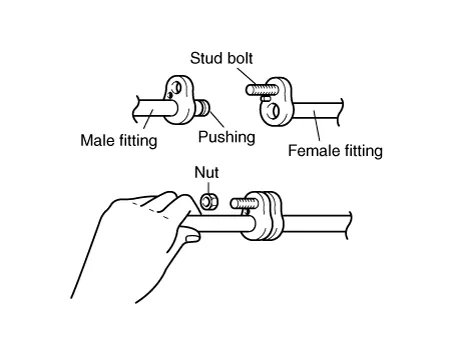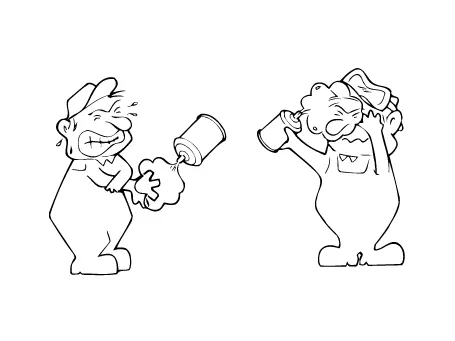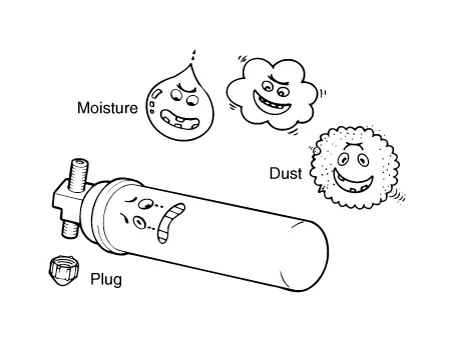Hyundai Ioniq (AE): Air Conditioning System / General safety information and caution
Hyundai Ioniq (AE) 2017-2022 Service & Repair Manual / Heating, Ventilation and Air Conditioning / Air Conditioning System / General safety information and caution
| Instructions |
When Handling Refrigerant
| 1. | R-134a, R-1234yf liquid refrigerant is highly volatile. A drop on the skin of your hand could result in localized frostbite. When handling the refrigerant, be sure to wear gloves. |
| 2. | It is standard practice to wear goggles or glasses to protect your eyes, and gloves to protect your hands. If refrigerant splashes into your eyes, wash them with clean water immediately. |
| 3. | The R-134a, R-1234yf container is highly pressurized. Never leave it in a hot place, and check if storage temperature is below 52°C (126°F) |
| 4. | An electronic leak detector should be used to check the system for refrigerant leakage. Bear in mind that the R-134a, R-1234yf, upon coming into contact with flame, produces phosgene, a highly toxic gas. |
| 5. | Use only recommended lubricant for R-134a, R-1234yf systems. If lubricants other than the recommended one used, system failure may occur. |
| 6. | POE lubricant absorbs moisture from the atmosphere at a rapid rate, therefore the following precautions must be observed:
|
| 7. | Do not use the same A/C recovery / charging station as conventional belt-driven compressors. |
| 8. | Since the electric compressor uses high-voltage, you should use POE oil which have high volumetric resistivity.
|
| 9. | If an accidental discharge in the system occurs, ventilate the work area before resume of service.
|
When Replacing Parts on A/C System
| 1. | Never open or loosen a connection before discharging the system. |
| 2. | Seal the open fittings of components with a cap or plug immediately to prevent intrusion of moisture or dust. |
| 3. | Do not remove the sealing caps from a replacement component until it is ready to be installed. |
| 4. | Before connecting an open fitting, always install a new sealing ring. Coat the fitting and seal with refrigerant oil before making the connection.
|
When Installing Connecting Parts
Flange With Guide Pin
Check the new O-ring for damage (use only the specified) and lubricate by using compressor oil. Tighten the nut to the specified torque.

Handling Tubing and Fittings
The internal parts of the refrigeration system will remain in a state of chemical stability as long as pure moisture-free refrigerant and refrigerant oil are used. Abnormal amounts of dirt, moisture or air can upset the chemical stability and cause problems or serious damage.
The Following Precautions Must Be Observed
| 1. | When it is necessary to open the refrigeration system, have everything you will need to service the system ready so the system will not be left open any longer than necessary. |
| 2. | Cap or plug all lines and fittings as soon as they are opened to prevent entrance of dirt and moisture. |
| 3. | All lines and components in parts stock should be capped or sealed until they are ready to be used. |
| 4. | Never attempt to rebind formed lines to fit. Use the correct line for the installation you are servicing. |
| 5. | All tools, including refrigerant dispensing manifold, gauge set manifold and test hoses, should be kept clean and dry. |
Refrigeration Cycle
Other information:
Hyundai Ioniq (AE) 2017-2022 Service & Repair Manual: PTC Heater. Description and operation
DescriptionThe PTC (Positive Temperature Coefficient) heater is installed at the exit or the backside of the heater core.The PTC heater is an electric heater using a PTC element as an auxiliary heating device that supplements deficiency of interior heat source in highly effective hybrid engine.
Hyundai Ioniq (AE) 2017-2022 Service & Repair Manual: Description and operation
DescriptionIn ordinary cars, the mechanical water pump mounted on the engine for heating purposes is activated to circulate the cooling water, but in hybrid cars, AEWP is used to circulate the cooling water when the engine is not operating. Classification System Cooling water used
Categories
- Manuals Home
- Hyundai Ioniq Owners Manual
- Hyundai Ioniq Service Manual
- Parking Distance Warning system (Reverse) malfunction, Check Active Air Flap System
- Tailgate Glass
- Theft-alarm System
- New on site
- Most important about car
Copyright © 2025 www.hioniqae.com - 0.0142



